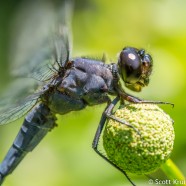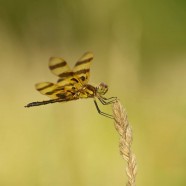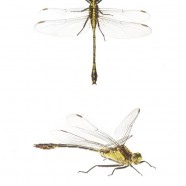Slaty Skimmer
This is an up close and personal look at the ruggedness of a male Slaty Skimmer (Libellula incesta) dragonfly, scratched and scarred from a tough life on the wing and seen here while resting on vegetation along a pond. That thorax looks rough and beaten on this mighty hunter, but after this was taken it was soon patrolling for females and fending off foes in the fight for life at the water. Don’t you always wonder what those enormous eyes have seen…while they undoubtedly keep a close watch on you? Just another hot July afternoon… Scott Kruitbosch Conservation & Outreach...
Read MoreHalloween Pennants (Celithemis eponina)
Sean recently had the enviable problem of many Halloween Pennants (Celithemis eponina) around! The beautiful dragonfly species was photographed wonderfully here by RTPI Affiliate Sean Graesser.
Read MoreLilypad Clubtail (Arigomphus furcifer)
Any day you manage to see a clubtail species is a good day in Sean’s book. He recently found this male Lilypad Clubtail (Arigomphus furcifer), and subsequently saw another trying to capture some Ebony Jewelwings along a forested stream. Photographed by RTPI Affiliate Sean Graesser for the Meet Your Neighbours global biodiversity project in Connecticut while on assignment for the Roger Tory Peterson Institute of Natural History.
Read MoreComet Darner
This is the Comet Darner (Anax longipes) that Twan recently netted before it went into the studio for its photo shoot – it certainly blends into the background beautifully!
Read MoreFamiliar Bluets
Here we have a pair of Familiar Bluet (Enallagma civile) damselflies in a “wheel”, a male and female joined together for mating. They are perched at a pond in this case but they can also fly this way. The male will likely remain with her until she lays the eggs. We are about to enter the prime flight time for our odonata – get out there to any local bodies of water to see what you can find. We will continue to survey for them across the Northeast to gain a greater knowledge of their distribution and abundance plus the health of our waterways.
Read More








